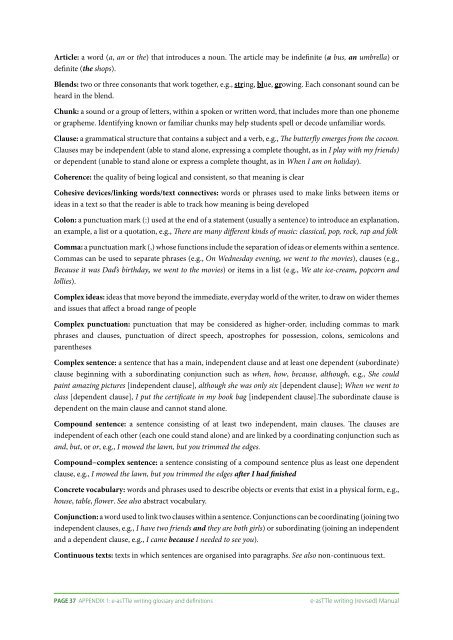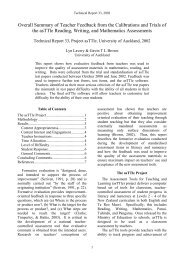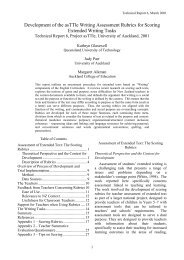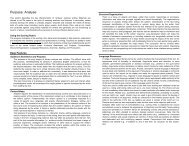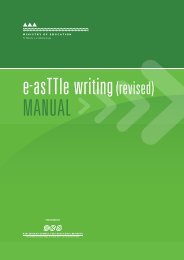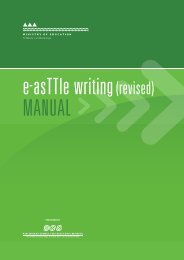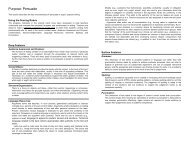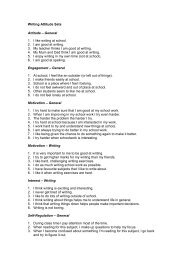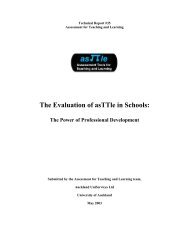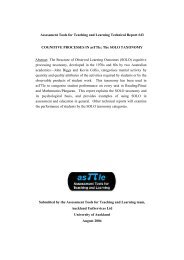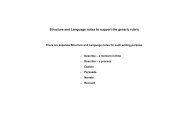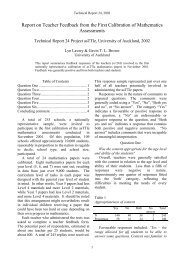e-asTTle writing (revised) Manual 2012 (3).
e-asTTle writing (revised) Manual 2012 (3).
e-asTTle writing (revised) Manual 2012 (3).
- No tags were found...
Create successful ePaper yourself
Turn your PDF publications into a flip-book with our unique Google optimized e-Paper software.
Article: a word (a, an or the) that introduces a noun. The article may be indefinite (a bus, an umbrella) ordefinite (the shops).Blends: two or three consonants that work together, e.g., string, blue, growing. Each consonant sound can beheard in the blend.Chunk: a sound or a group of letters, within a spoken or written word, that includes more than one phonemeor grapheme. Identifying known or familiar chunks may help students spell or decode unfamiliar words.Clause: a grammatical structure that contains a subject and a verb, e.g., The butterfly emerges from the cocoon.Clauses may be independent (able to stand alone, expressing a complete thought, as in I play with my friends)or dependent (unable to stand alone or express a complete thought, as in When I am on holiday).Coherence: the quality of being logical and consistent, so that meaning is clearCohesive devices/linking words/text connectives: words or phrases used to make links between items orideas in a text so that the reader is able to track how meaning is being developedColon: a punctuation mark (:) used at the end of a statement (usually a sentence) to introduce an explanation,an example, a list or a quotation, e.g., There are many different kinds of music: classical, pop, rock, rap and folkComma: a punctuation mark (,) whose functions include the separation of ideas or elements within a sentence.Commas can be used to separate phrases (e.g., On Wednesday evening, we went to the movies), clauses (e.g.,Because it was Dad’s birthday, we went to the movies) or items in a list (e.g., We ate ice-cream, popcorn andlollies).Complex ideas: ideas that move beyond the immediate, everyday world of the writer, to draw on wider themesand issues that affect a broad range of peopleComplex punctuation: punctuation that may be considered as higher-order, including commas to markphrases and clauses, punctuation of direct speech, apostrophes for possession, colons, semicolons andparenthesesComplex sentence: a sentence that has a main, independent clause and at least one dependent (subordinate)clause beginning with a subordinating conjunction such as when, how, because, although, e.g., She couldpaint amazing pictures [independent clause], although she was only six [dependent clause]; When we went toclass [dependent clause], I put the certificate in my book bag [independent clause].The subordinate clause isdependent on the main clause and cannot stand alone.Compound sentence: a sentence consisting of at least two independent, main clauses. The clauses areindependent of each other (each one could stand alone) and are linked by a coordinating conjunction such asand, but, or or, e.g., I mowed the lawn, but you trimmed the edges.Compound−complex sentence: a sentence consisting of a compound sentence plus as least one dependentclause, e.g., I mowed the lawn, but you trimmed the edges after I had finishedConcrete vocabulary: words and phrases used to describe objects or events that exist in a physical form, e.g.,house, table, flower. See also abstract vocabulary.Conjunction: a word used to link two clauses within a sentence. Conjunctions can be coordinating (joining twoindependent clauses, e.g., I have two friends and they are both girls) or subordinating (joining an independentand a dependent clause, e.g., I came because I needed to see you).Continuous texts: texts in which sentences are organised into paragraphs. See also non-continuous text.Page 37 Appendix 1: e-<strong>asTTle</strong> <strong>writing</strong> glossary and definitionse-<strong>asTTle</strong> <strong>writing</strong> (<strong>revised</strong>) <strong>Manual</strong>


